
Malaysians have the conviction that Singaporeans are doing far better than Malaysians do. In many specialized areas, indeed, the level of superiority of Singapore seems to be light years away compared to Malaysia. However when all things are smoothened out, and the data is generalized over the entire country (Malaysia is much bigger and populous than its neighbor, by as much as 1,400 times and 6 times respectively), we can see that the overly emphasized achievements of Singapore (or the lack of achievements on the part of Malaysia) will fall apart.
The most overarching example is the comparison of the exchange rate between the two countries.
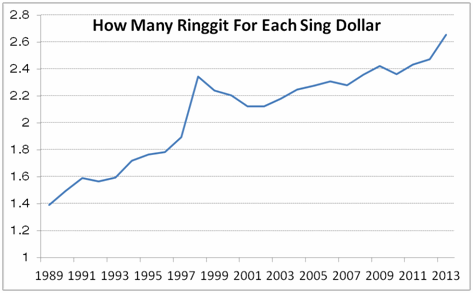
Figure 1: The graph shows ever more Ringgit to buy One Singapore Dollar
The simple comparison between the Ringgit and the Singapore Dollar exchange rateshows how the perception of Malaysians towards their own country and towards their own economic performance, vis-à-vis that of Singapore, can be described generally in one word— downbeat. This is despite Malaysia’s superb economic performance in the last few decades, uplifting millions of its population into the middle class and the upper income brackets, and by almost eliminating the fully hardcore poor. Comparing a smaller country such as Singapore, to a bigger country such as Malaysia can be a difficult feat, since no two countries can be easily compared on an even basis. Because of the prevailing perception that Singapore is better, Malaysians continue to strive harder to catch up, without knowing how they actually performed.
The graph of Figure 1 above can be very misleading without the proper context and other additional data. If we compare both currencies to the US Dollar the result will be different.
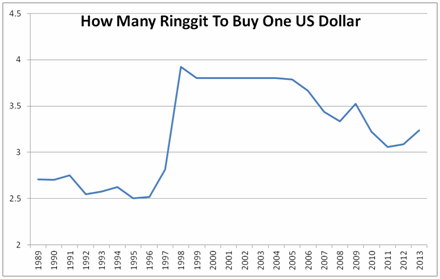
Figure 2: How many Ringgit is required to buy one US Dollar since 1989
Compared to the US Dollar, the Malaysian Ringgit has not lose ground that much. Since 1989, the loss is about 20%. But if we extend the timeline much further to the past, the conclusion is again, quite different.
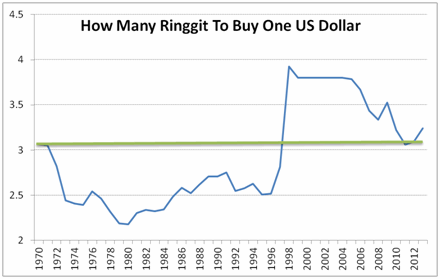
Figure 3: How many Ringgit is required to buy one US Dollar since 1970
Basically, there was no change in the forty something years between the two currencies (Ringgit and United States Dollar). It is clear that the Ringgit has not lost ground compare to the world’s reserve currency.
Singapore Dollar on the other hand, has appreciated steadily, especially in the last decade or so.
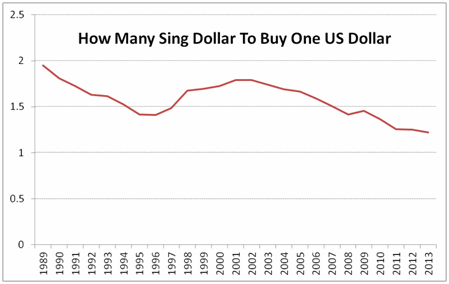
Figure 4: How many Singapore Dollar for buying one US Dollar since 1989
It is clear that relative to the United States Dollar, the Ringgit has not lost any ground while the Singapore Dollar has gained ground, on both currencies. So the conclusion is that it is not that the Malaysian Ringgit devalued against Sing Dollar, but on the contrary, it is Sing Dollar that has appreciated against not just the Ringgit, but other currencies as well, including the US Dollar.
In the simple example of declining exchange rate between Singapore Dollar and the Malaysian Ringgit, many people were ‘duped’ by exchange rate mirage. A low exchange rate has never meant a country is poor, or not “rich enough”. For example a country such as Japan, considered one of the richest in the world, is having a much lower exchange rate compared to the Ringgit; Each Ringgit could buy as many as 30 Yens. Therefore, despite a nation’s currency going lower in terms of exchange rate, a country could still be growing wealthier at the same time, leaving no impact whatsoever other than increased wealth. The exchange rate of a currency in circulation is also determined by the number of outstanding ‘units’ in circulation. It is no different compared to the issued and traded stock of a corporation in the stockmarket. A company’s stock that is priced around twenty dollars is by no mean is having a lower profit compared to another company’s stock that is priced at 80 dollars. Both could be earning the same amount of profit; but because the numberof outstanding shares issued into circulation differed by perhaps a multiple of four, then these two companies are essentially similar in performance and value. Their only difference is the number of shares in circulation.

Figure 5: Although Company A share price is higher, in reality their value is the same as for every dollar invested into each stock, the return is identical to each other
Similarly for the case of Malaysia and Singapore, the number of currency in circulation could determine the exchange rate between them (higher or lower), despite the countries having the same economic performance. [It is not true that a high priced stock has a lot of way to go when it is going down compared to a lower priced stock, when shown mathematically]
When we compare two different companies, we compare their “profit generation”, their assets and their debts, and most importantly, their future prospect. We do not compare companies based on the stock prices between them. So for the case of Malaysia and Singapore, we should try to compare both countries using better metrics. Everyone should discard a direct comparison of the exchange rate, because it is meaningless over a longer term.
Currency in Circulation
The amount of currency in circulation would directly influence the value of the currency. In this instance, if Malaysia printed and circulated more Ringgit into its economy (than naturally demanded), its value would naturally be lower, or going down. Despite the resulting inflation, there is hardly much impact on the generalpopulation related to this overprinting because each of the citizens would be receiving more Ringgit in his or her hands which is used to pay for the increase in services and products prices. [Only economists and statisticians would be screaming because of their ‘data’]
Let’s compare the number of “outstanding” currency in circulation in Singapore and also that of in Malaysia. Perhaps this should shed some light on the “profit generation” and other metrics mentioned earlier.
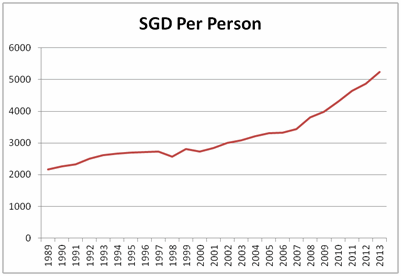
Figure 6: Rate of increase of Singapore Dollar in circulation relative to the population (including expatriates)
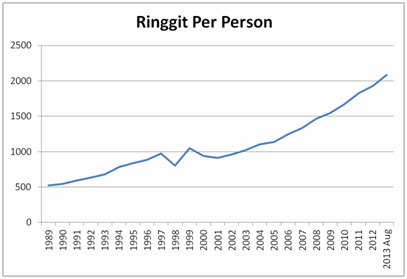
Figure 7: Rate of increase of the Ringgit in circulation relative to the population (including expatriates)

Figure 8: In percentage terms, the rate of increase of the Malaysian Ringgit is almost double than that of the Singaporean Dollar
[Data obtained from the Monetary Authority of Singapore and Bank Negara Malaysia as well as from the statistics department of both countries]
Further analysis of broad quasi money between the two nations revealed that Malaysia’s rate is considerably faster than that of Singapore’s rate. It grew by 400% in Singapore and 760% in Malaysia. For demand deposit, Singapore grew by 870% while Malaysia grew by 1,050%.
From the data, it is clear that Malaysia’s central bank (BNM) is printing Ringgit more aggressively than its Singapore counterpart, the Monetary Authority of Singapore (MAS). Or perhaps, BNM was printing appropriately, that it was MAS that was underprinting all the while, causing the exchange rate of the Singapore Dollar to go up. Or it could be a little bit of both. Central banks need to be mindful on the amount of money they are printing. It is best if they only print according to actual monetary demand, but with a slight buffer. As shown in 259 Trillion Vs 5 Trillion book series, central banks always backed the printed currency with new wealth. If too much overprinting occurs, the value of the currency would naturally go down.
Now for Fixed Deposits, the difference between Malaysia and Singapore is even larger as shown below.
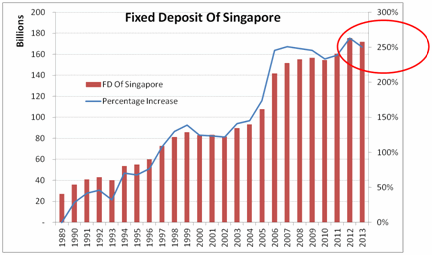
Figure 9: Fixed Deposits in Singapore increased considerably since 1989
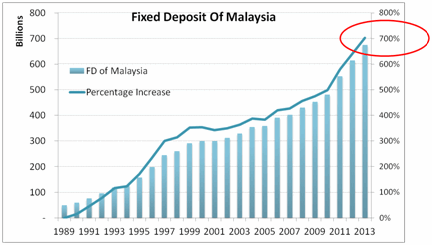
Figure 10: Tremendous increase in Fixed Deposits in Malaysia since 1989 which is twice the rate as in Singapore
It seems that despite the devaluation of the Ringgit, Malaysians saved more of their income to compensate. The increase in fixed deposits is one but of many ways for showing the creation of wealth in a particular country.
Wealth
Every year, both countries added new wealth into their economies. But who added more? And who added more, per capita?
The answer is quite surprisingly, it’s Malaysia.
Not just Malaysia added more wealth yearly compared to Singapore, Malaysia also added more wealth for each of its citizen. This is pretty contrarian, but many people were caught by the illusions created by the high concentration of Singapore’s wealth within a very small area, and certainly of small population. No doubt Singaporeans are richer in absolute numbers, but our focus was, who did better in the last few years, and who is catching up to whom, during the period in focus.
The charts below show the level of net wealth of Malaysia compared to Singapore, in absolute numbers and also in percentage change. During the comparison period, Malaysia added wealth at a faster pace than Singapore, exceeding 220% to Singapore’s 140% since 2002. Net wealth is derived by deducting gross wealth with outstanding debt.

Figure 11: A double chart showing the net wealth of each country and the percentage increase, in their respective currencies.

Figure 12: Another double chart showing the net wealth of each country and the percentage increase, this time presented in US Dollar.

Figure 13: A double chart showing the percentage increase of per capita net wealth for Malaysia and Singapore, expressed in US Dollar.
In every respect, Malaysia is clearly charging ahead faster than Singapore, by adding more wealth per capita, for each of its citizen, catching up to Singapore and narrowing the wealth gap. This statistic is however lost when one portray the larger Malaysia by concentrating on its number of the poor or the unfortunate, compared to a smaller Singapore. For example, the bottom 10% of the population in Malaysia will yield far too many people, compared to a similar 10% in Singapore in absolute terms. Malaysia’s wealth is also more widely dispersed throughout the country which is a good thing. For Singapore, it is not possible to make such a comparison, because it is just a city state. Should the inhabitants of Kuala Lumpur collects its own tax and used it all for themselves and within their border only, they would probably match or even exceed the city of Singapore in many respects, including income and wealth. The average salary of Kuala Lumpur city dwellers is easily doubled or even tripled than the rest of Malaysia (data from Statistics Department, Malaysia). Currently taxes are centralized and redistributed throughout Malaysia in many ways that poorer states may receive far higher money than their actual tax contribution. If Sarawak was to use all of its oil and gas proceeds for its own use, it could be another Brunei by now.
When we look at the prospect and the achievement of Malaysia’s economy, we will realize that size, geography, governance and other factors matter greatly. These factors enable Malaysia to be on a very nice and sweet place within high economic growth nations. But then, so is Singapore. Both countries enjoy similar level of pluses, and the biggest plus these days, is the further economic links between the two due to their proximity and openness. While competing, they also can cooperate. The message is clear; by combining their best and brightest, both countries can improve their standard of living better and faster. Such are the benefits of open capitalism.
The notion that elevated exchange rate for a currency means a country is performing better is not necessarily a correct one, especially over the long term where other factors such as the amount of currency in circulation will yield higher influence.
Cost of Living and Purchasing Power
After calculating all the money and wealth of both countries, one may still be unsure about the ‘capabilities’ of the numbers to ‘perform’. Indeed, we need to know how much of such wealth can actually be used to purchase products and services in the economy. This is an important question to be answered. We need to check the purchasing power of the currency of each of the country, and see what can be bought and how much is required for such purchases. To present them in an equal manner, we will need to buy the same kind of product, or services, in equal size, quality and other parameters. One such measurement we can use is the Big Mac Index, championed by “The Economist Magazine” to show just how much the famous McDonald’s Big Mac in many countries. It is a convenient and simple index, because the Big Mac retained most of its specific parameters in each of the countries. As a global company, McDonalds went the extra mile in making the burger’s taste as similar as possible, to meet buyer’s expectation, where ever they are.
According to the index, the Big Mac burger is certainly cheaper in Malaysia than in Singapore. Just a few kilometers away from the border between Malaysia and Singapore, the price of the Big Mac will drop like a brick, from 3.75 US Dollars to only 2.34 US Dollars (-38%). Although Malaysians earns less in income, they can afford to buy the same burger Singaporeans could, at only 62% of the price. Back in 2003, the Big Mac is cheaper in Malaysia by only 28%. Now it is even cheaper, essentially meaning that Singaporeans higher incomes are largely used to pay more for living expenses. Based on the Big Mac Index, with roughly just 40% more incomes, Singaporeans must pay 330% more in rents, 220% more for a simple meal in a restaurant, 120% for a bottle of water, 264% for basic utilities and finally, 450% more for buying apartments, compared to Malaysians. The big incomes Singaporeans have will become not so big when all of these are taken into account (data obtained from numbeo.com). In 2014, Singapore was finally voted as the most expensive city in the world, more than New York or even Tokyo. A million dollars in Singapore may not go far compare to other cities.
Of course the Big Mac Index has its limitations, and if we compare each and every item in a consumer expenses list, we will realize that some items could be cheaper in the other country when corrected for the disposable income. According to numbeo.com, the cost of living index is 50 in Kuala Lumpur, and 105 in Singapore which is almost identical with the differential average income of Malaysians and Singaporeans (slightly more than double).
Singaporeans are always considered to be rich by Malaysian standard. Many are considered ‘millionaires’, so how many millionaires are there in Singapore? Based on Credit Suisse’s study, there are 174,000 millionaires in Singapore. In Malaysia, there are 38,000. These millionaires are based on US Dollars millionaire, so in local Ringgit currency, one must have 3 plus million in order to be one. However we already knew that such an amount of money goes a very long way in Malaysia, so compared to Singapore, there are actually far many more real millionaires in Malaysia (when corrected for their actual purchasing powers).
Credit Suisse predicts that within five years, the number of Malaysia’s millionaire will jump by 76% while that of Singapore, by ‘only’ 35%. Even the United States will add millionaires faster than Singapore, adding a total of 5.5 million (this is the entire population of Singapore by the way), to its already world’s largest millionaire population (imagine for instance the entire peninsular is made of millionaires).
The symbiosis between Malaysia and Singapore goes very far and very deep. It is a great engine of wealth creation. Already in 2013, both Malaysia and Singapore combined has more real millionaires than South Korea, despite having only half of the population. This great engine must be allowed to continue and expand, so that the whole world would benefit.
Collectively, Malaysian companies currently outnumber Singapore in terms of their market value as shown in the chart below.
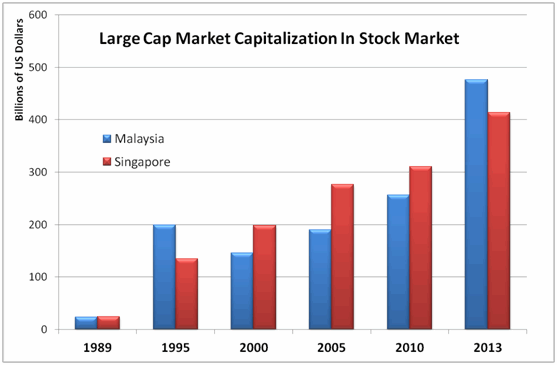
Figure 14: Chart showing the market capitalization of large cap companies in both countries [data obtained from the World Bank].
The market value of Malaysian companies is growing faster than their Singaporean counterpart, collectively. However looking from another angle, one can also see the might of the Singapore’s economy in creating wealth.
As a conclusion, it is not so bad to stay and live in Malaysia. Despite having lower incomes, Malaysian enjoys good purchasing power, in many ways, exceeding other countries including its closest neighbor. Malaysians are growing richer much faster than their neighbor, and the great wealth engine will not be able to do it without the symbiosis in the two economies. To Malaysians, don’t take the economic freedom and wealth for granted. There are many rent seekers waiting to exploit your complacency. They can be politicians, religionists and many more. Don’t give up your freedom for them. You created the wealth, they don’t. Yet, they want to take it from you. And remember, higher exchange rate can mean nothing between two currencies, but the actual purchasing power does. And to Singaporeans, just travel a few kilometers over the border and stretch your incomes by several magnitude. This is how the symbiosis works and this is how it will be for a long time, therefore we should treat each other with open arms.
This article was written by Sharif Rahman, the co-author of 259 Trillion Vs 5 Trillion book series and on a book explaining the Occupy Wall Street movement. He can be contacted at his email at sirikegagalanemas@yahoo.com

With Gain Credit Personal Loans, you can get instant loan/money for a wide range of your personal needs like renovation of your home, marriage in the family, a family holiday, your child's education, buying a house, medical expenses or any other emergencies. With minimum documentation, you can now avail a personal loan at attractive 3% interest rates. This is trust and honest loans which you will not regret, Contact us via Email: gaincreditloan01@gmail.com
ReplyDeleteYour Full Details:
Full Name. . .. . .. . .. . .. . .
Loan Amount Needed. . ...
Loan Duration. . .. . .. . .. . .
Phone Number. . .. . .. . ..
Applied before. . .. . .. . ..
Country. . .. . .
Email Us: gaincreditloan01@gmail.com